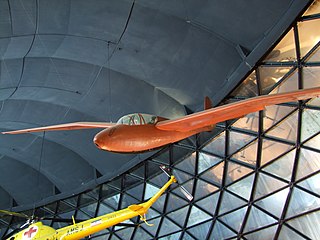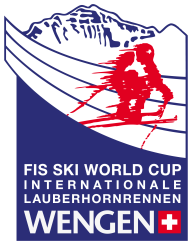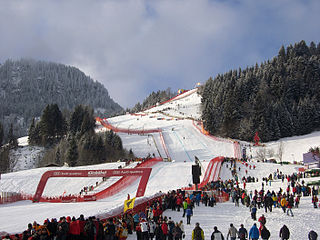
Water skiing is a surface water sport in which an individual is pulled behind a boat or a cable ski installation over a body of water, skimming the surface on two skis or one ski. The sport requires sufficient area on a stretch of water, one or two skis, a tow boat with tow rope, two or three people, and a personal flotation device. In addition, the skier must have adequate upper and lower body strength, muscular endurance, and good balance.

Downhill is a form of alpine skiing competition. Whereas the other alpine skiing events emphasize turning and technique, downhill emphasizes "the six components of technique, courage, speed, risk, physical condition and judgement", according to the FIS "International Ski Competition Rules (ICR)". Speeds of up to 130 km/h (81 mph) are common in international competition. Athletes must have an aerodynamically efficient tuck position to minimize drag and increase speed.
The men's downhill of the 2006 Winter Olympics was held at Sestriere, Italy, on Sunday, 12 February.
The Men's Super-G competition of the Torino 2006 Olympics was held at Sestriere, Italy, on Saturday, February 18.

Nakiska is a ski resort in western Canada, in the Kananaskis Country region of the province of Alberta. It is located 83 km (52 mi) from Calgary, west on Highway 1 and south on Highway 40. "Nakiska" is a Cree word meaning "to meet" or "meeting place."

The men's combined event was part of the alpine skiing programme at the 1936 Winter Olympics. It was the debut of alpine skiing at the Winter Olympics, and was the only men's event. The competition consisted of a downhill race on Friday, 7 February and two slalom heats on Sunday, 9 February.

The women's combined event was part of the alpine skiing program at the 1936 Winter Olympics. It was the debut of alpine skiing at the Winter Olympics, and was the only women's event. The competition consisted of a downhill race on Friday, 7 February and two slalom runs on Saturday, 8 February. Thirty-seven alpine skiers from 13 nations competed.

The men's alpine skiing downhill event of the 1956 Winter Olympics at Cortina d'Ampezzo, Italy, was held on Friday, 3 February, at 11:00 a.m. The starting elevation on the Olimpia - Tofana run was 2,282 m (7,487 ft) above sea level and the course length was 3.461 km (2.15 mi), with a vertical drop of 902 m (2,959 ft) and just fifteen control gates.
The Men's downhill competition of the 2009 World Championships at Val-d'Isère, France, was run on Saturday, February 7, the fourth race of the championships.

Birds of Prey is a World Cup downhill ski course in the western United States, located at Beaver Creek Resort in Avon, Colorado. The race course made its World Cup debut 27 years ago in December 1997.

The Men's Downhill competition of the Vancouver 2010 Olympics was held at Whistler Creekside in Whistler, British Columbia. The competition was scheduled for Saturday, February 13, but was postponed due to rain and warm temperatures; it was held on Monday, February 15.
The women's downhill competition of the Vancouver 2010 Olympics was held at Whistler Creekside on Wednesday, February 17.
The marquee event of alpine skiing was held on Sunday, February 10, at the Snowbasin ski area, east of Ogden under clear skies.
Steve McKinney was an American Alpine skier and mountaineer who is acknowledged as an early pioneer in the sport of extreme skiing. A gifted all-around athlete, McKinney is best remembered as a world-class speed skier. In 1978 at Portillo, Chile, McKinney's record-breaking run of 200.222 km/h (124.137 mph) made him the first speed skier to break the 200 km/h barrier. Between 1974 and 1987, McKinney set seven world speed skiing records in competitions around the world.

The Ikarus Košava is a two-seat sailplane designed and built in Yugoslavia in the early 1950s. It won the 1954 World Gliding Championships in the two seat category and came second in the same event two years later.
The Men's Downhill competition of the Albertville 1992 Olympics was held at Val d'Isère on Sunday, 9 February.

The Men's downhill competition of the 1964 Winter Olympics at Innsbruck, Austria, was held at Patscherkofel on Thursday, 30 January. The defending world champion was Karl Schranz of Austria, and defending Olympic champion Jean Vuarnet of France had retired from competition.
Edmond Plawczyk is a French speed snowboarder living in Chateau d'Oex. In April, 2013, he became the fastest snowboarder in the world, with a speed of 203 km/h.

The Lauberhorn ski races (Lauberhorn World Cup alpine ski races are among the highest-attended winter sports events in the world, attracting around 30,000 spectators each year. An established attraction is the airshow by the Patrouille Suisse, the aerobatic demonstration team of the Swiss Air Force. The 2016 races were held 15–17 January.

Streif is a World Cup downhill ski course in Austria, located on Hahnenkamm mountain in Kitzbühel, Tyrol, and has hosted the Hahnenkamm Races since 1937.












